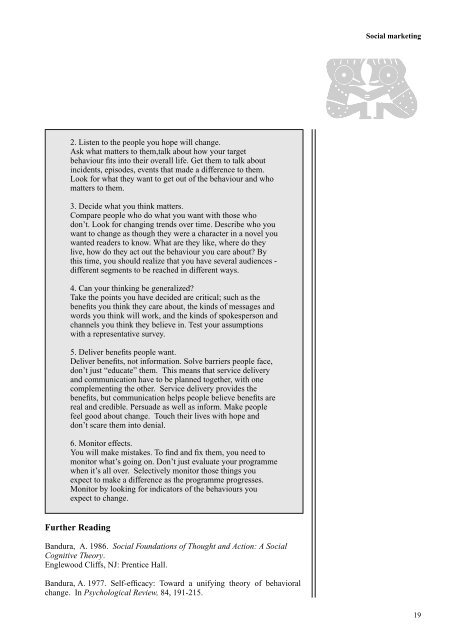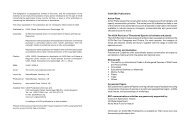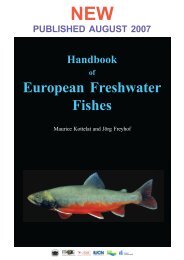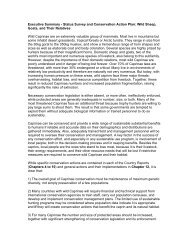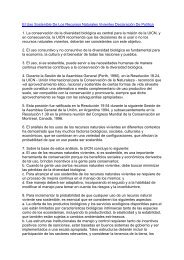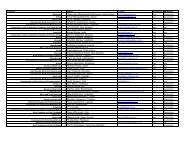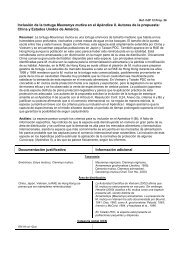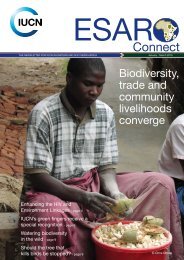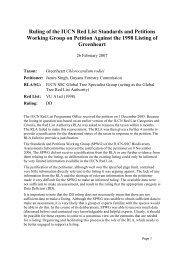Planning education to care for the earth - IUCN Knowledge Network
Planning education to care for the earth - IUCN Knowledge Network
Planning education to care for the earth - IUCN Knowledge Network
Create successful ePaper yourself
Turn your PDF publications into a flip-book with our unique Google optimized e-Paper software.
Social marketing2. Listen <strong>to</strong> <strong>the</strong> people you hope will change.Ask what matters <strong>to</strong> <strong>the</strong>m,talk about how your targetbehaviour fits in<strong>to</strong> <strong>the</strong>ir overall life. Get <strong>the</strong>m <strong>to</strong> talk aboutincidents, episodes, events that made a difference <strong>to</strong> <strong>the</strong>m.Look <strong>for</strong> what <strong>the</strong>y want <strong>to</strong> get out of <strong>the</strong> behaviour and whomatters <strong>to</strong> <strong>the</strong>m.3. Decide what you think matters.Compare people who do what you want with those whodon’t. Look <strong>for</strong> changing trends over time. Describe who youwant <strong>to</strong> change as though <strong>the</strong>y were a character in a novel youwanted readers <strong>to</strong> know. What are <strong>the</strong>y like, where do <strong>the</strong>ylive, how do <strong>the</strong>y act out <strong>the</strong> behaviour you <strong>care</strong> about? Bythis time, you should realize that you have several audiences -different segments <strong>to</strong> be reached in different ways.4. Can your thinking be generalized?Take <strong>the</strong> points you have decided are critical; such as <strong>the</strong>benefits you think <strong>the</strong>y <strong>care</strong> about, <strong>the</strong> kinds of messages andwords you think will work, and <strong>the</strong> kinds of spokesperson andchannels you think <strong>the</strong>y believe in. Test your assumptionswith a representative survey.5. Deliver benefits people want.Deliver benefits, not in<strong>for</strong>mation. Solve barriers people face,don’t just “educate” <strong>the</strong>m. This means that service deliveryand communication have <strong>to</strong> be planned <strong>to</strong>ge<strong>the</strong>r, with onecomplementing <strong>the</strong> o<strong>the</strong>r. Service delivery provides <strong>the</strong>benefits, but communication helps people believe benefits arereal and credible. Persuade as well as in<strong>for</strong>m. Make peoplefeel good about change. Touch <strong>the</strong>ir lives with hope anddon’t s<strong>care</strong> <strong>the</strong>m in<strong>to</strong> denial.6. Moni<strong>to</strong>r effects.You will make mistakes. To find and fix <strong>the</strong>m, you need <strong>to</strong>moni<strong>to</strong>r what’s going on. Don’t just evaluate your programmewhen it’s all over. Selectively moni<strong>to</strong>r those things youexpect <strong>to</strong> make a difference as <strong>the</strong> programme progresses.Moni<strong>to</strong>r by looking <strong>for</strong> indica<strong>to</strong>rs of <strong>the</strong> behaviours youexpect <strong>to</strong> change.Fur<strong>the</strong>r ReadingBandura, A. 1986. Social Foundations of Thought and Action: A SocialCognitive Theory.Englewood Cliffs, NJ: Prentice Hall.Bandura, A. 1977. Self-efficacy: Toward a unifying <strong>the</strong>ory of behavioralchange. In Psychological Review, 84, 191-215.19


